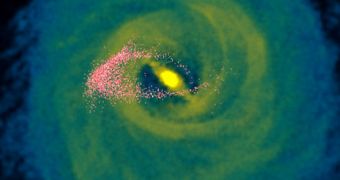Astronomers have recently determined that our galaxy, the Milky Way, most likely consumed a nearby dwarf galaxy some 700 million years ago. The discovery was made after experts found “leftovers” from the massive cosmic feast.
These leftovers come in the form of stars. Some of these objects behave in a peculiar manner, that experts say is not in tune with how they should be acting, had they originated in the Milky Way.
On the other hand, their properties and behaviors would make sense if they were formed some place else, and then were engulfed in a galactic merger. Such events occur quite often when massive galaxies such as our own meet their smaller, much less massive neighbors.
In addition to explaining some aspects of the weirdest stars in the galaxy, the new discovery also lends additional credence to the theory holding that the most massive galaxies in the Universe reach their impressive size by consuming dwarf galaxies in their surroundings.
Experts say that, otherwise, it becomes very difficult to explain why these objects reach their impressive dimensions. Mergers would also explain why intense episodes of stellar formation occur from time to time.
When two galaxies collide, they do not fall directly into each other. Rather, they tend to circle each other for millions of years, interacting only loosely, before putting their matter together.
As the process unfolds, the stagnant masses of hydrogen gas and cosmic dust the two objects contain are stirred up again, and they start forming stellar nurseries. In turn, these structures then produce large numbers of new, blue stars.
The stars that led to the new study, and subsequent discoveries, were discovered by Astrophysical Institute Potsdam researcher Mary Williams and her colleagues. The team found a “stream” of 15 stars, that all had similar speeds and chemical compositions.
These properties immediately set them apart from the rest of the stars in the galaxy, of which 250,000 were surveyed using the Australian Astronomical Observatory in Siding Spring.
The German researchers say that the star stream is located in the constellation Aquarius. Williams and her team detail their discovery in the February 20 issue of the esteemed Astrophysical Journal.
Stars such as these ones indicate that they were eaten by our galaxy, not formed here. However, the study team admits that it needs to refine its calculations a bit. At this point, the age of the merger has an uncertainty of +/- 350 million years.
“Once more detailed simulations of Aquarius are performed, we’ll have a better grasp of its age and evolution,” Williams says, quoted by Science News.

 14 DAY TRIAL //
14 DAY TRIAL //